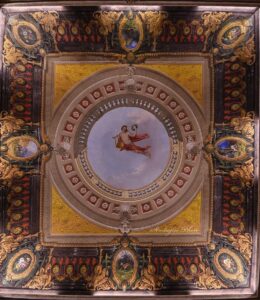
The Palazzo consists of a Baroque-style quadrilateral rebuilt after the partial collapse due to the 1693 earthquake, with its main entrance located at Via San Bonaventura 22, a central street to the left of the famous Santa Maria del Monte staircase. It is one of the oldest palaces in Caltagirone, reconstructed on a pre-existing sixteenth-century structure, also linked to the unfinished palace belonging to Bonaventura Secusio, Bishop of Catania and diplomat born in Caltagirone in 1558. The reconstruction work was started in 1725 by Barbaro Maggiore, Marquess of Santa Barbara, and completed in 1732. Inside the Palazzo, in the part now called the “Representative Wing,” the Arcadian colony meetings founded in Caltagirone by Barbaro Maggiore’s son, Giuseppe, were held in the second half of the eighteenth century.
In 1871, a descendant of Barbaro Maggiore sold most of the Palazzo to his relative Michelangelo Libertini, Noble of the Barons of S. Marco Lo Vecchio, Patrician of Caltagirone. He made the noble floor of what is now number 22 his lavish residence, furnished with white lacquered and gold-plated fittings, French-made furniture, painted glass doors, damask wallpapers, and Aubusson carpets, commissioned from the most important French textile manufacturers specifically for the designated halls. The ceilings of the halls, whose layout was remodeled from the original Maggiore design, were decorated by the best local artists and enriched with canvases by Francesco Vaccaro, a member of the renowned Bongiovanni-Vaccaro family of artists, whose works are present in the churches and museums of Caltagirone and the Ragusa area.
From Michelangelo Libertini, the property of the Palazzo passed to his children, Gesualdo, an important deputy of the Giolittian faction elected in the Caltagirone district and appointed in 1920 as a Senator for Life of the Kingdom of Italy, and Francesca, married to Commendatore Salvatore Spadaro di Passanitello, a member of the notable baronial family of Mineo originally from Scicli. The political following, along with the prestigious positions held by Sen. Gesualdo Libertini, especially as Secretary to the Presidency of the Senate, ensured that the Representative Halls of the Palazzo enjoyed the reflected prestige of Senator Libertini. In the absence of direct descendants, Sen. Gesualdo Libertini (who died in 1945) bequeathed all his assets to his nephew Francesco Spadaro di Passanitello, the son of his sister Francesca, a distinguished historian, heraldist, archaeologist, and beloved mayor of Caltagirone. Subsequently, by the choice of the owner, Arch. Alvise Spadaro Gravina, a well-known art historian and great connoisseur of Caravaggio, the Representative Halls of the Palazzo became the headquarters of primary institutions and, within this framework, welcomed prominent figures from the literary and political worlds not only of Sicily but also nationally. The Palazzo, known as Palazzo Libertini until the death of Sen. Libertini, took the name Palazzo Spadaro Libertini or Palazzo Spadaro for brevity once it passed to Cav. Francesco Spadaro. In 2001, the Palazzo was declared a monumental property of significant artistic interest by the Sicilian Regional Department of Cultural Heritage, especially due to the Representative Wing, which has preserved notable artistic and historical elements. The Palazzo is thus under the direct protection of the Superintendence for Cultural and Environmental Heritage of Catania. Over the centuries, the close family ties between the four families that have owned the Palazzo—the Maggiore, Libertini, Spadaro, and Gravina families—and the cultural and historical affinities, along with the affection between Arch. Alvise Spadaro Gravina, his wife Donna Letizia Spadaro, and their cousins Gemma and Lara Gravina of the Belmonte Beaumont branch, led to the successful “passing of the torch” of the parts of the Palazzo owned by Arch. Spadaro to his cousin Lara. Born in Milan but deeply connected to Sicily and the millenary roots and traditions of the Gravina family in Sicily, Lara, to fulfill her late father Enrico’s wishes, undertook and successfully completed, together with her mother Gemma, the complete restoration of the Representative Wing and other parts of her property in the Palazzo, consolidating a large portion of the entire building and creating an autonomous unit connected by an internal elevator, earning it the title of a “Palace within a Palace.”
